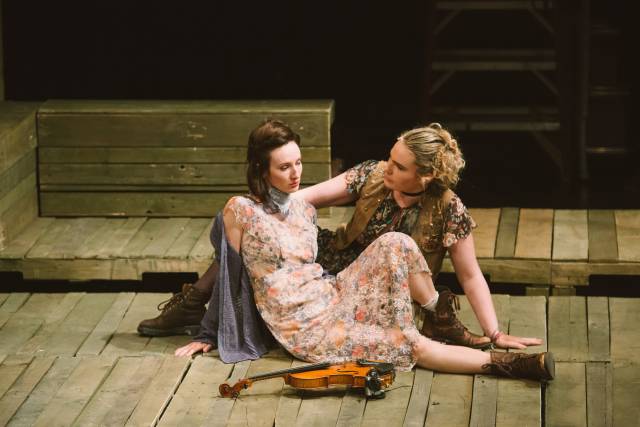

“It’s tiresome acting like something you’ve never been” says Abraham (Adrian Blake Enscoe) to Angelina (Elizabeth A. Davis), and even though he’s making a personal confession in the hopes of finally becoming free, he might as well have been talking about the changes Dust Can’t Kill Me underwent from its 2014 production at FringeNYC to the streamlined, vibrant version presented at the 2016 New York Musical Festival. In 2014 the musical believed itself to be a book property and approached its allegorical storytelling straight-faced, leading to an uneven experience in which the songs stuck out like sore, but welcome, thumbs surrounded by gloomy events and grandiose metaphors. By 2016 it’s become clear to its creators that the musical’s power always lied in the gorgeous tunes by Elliah Heifetz, and the book by Abigail Carney has been retooled by director Srda Vasiljevic to become a stage rather than a cage.
Vasiljevic revitalized the story of lost souls wandering in the 1936 Dust Bowl, by adding a John Doyle-esque framing device which sees the actors not only playing their own instruments, but also being hyper-aware of the fact they’re playing characters, instantly making the musical less tragic. This clever method opens up the musical in such an exhilarating way that the show could now work with ease as campfire storytelling, and also within the comforts of a New York theater.
The director, who worked in the Deaf West production of Spring Awakening, understands the “less is more” approach and repurposes the instruments so that when needed they can become babies or shotguns, making for an experience that holds much more surprises than one would get from traditional props. The set by Reid Thompson, consists of wooden platforms and crates that are moved around so that at times the band can look both like bonafide rock stars and also nomadic spirits taking their tales from town to town.
Since the plot is more impressionistic than straightforward, director Vasiljevic allows each of his actors to embody the traits that best identify their characters. Blake Enscoe’s Abraham for instance infuses his banjo and mandolin with a haunting romantic quality that’s positively Keats-ian, Richard Crandle’s drum becomes an enough-is-enough cry of war, Paul Hinkes’ sensuous guitar encompasses the charms of the seductive Preacher, and Davis’ violin cries as many tears as it inspires sighs. But it’s Kathryn Gallagher as Lily who gives the show’s most ferocious, unforgettable performance, guitar in hand she becomes a warrior set on defeating the odds, a Katniss Everdeen in bluegrass form.
The concert setting has also allowed the show’s themes to become more relevant than ever, while the 2014 production imposed the subject matters on its characters, in 2016 these lost souls seeking refuge from a world that fails to understand them become an eerie foreboding of what America would be like under a Republican regime. If the show suggests that in 1936 a Utopia where people could be free regardless of sexual orientation, race, religion or gender, could only mean death and oppression, 80 years into the future and things aren’t precisely looking any better. But what this re-imagined Dust Can’t Kill Me achieves is precisely convincing us that a bright future isn’t only possible, but in fact the only option.